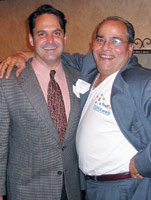FedEx Event Spotlights Global Logistics
The future of Southern California and FedEx’s role in that future for apparel and textile manufacturers were on the agenda at an Aug. 24 dinner seminar hosted by the Memphis, Tenn.–based freight carrier at the Wilshire Grand Hotel in downtown Los Angeles.
Issues such as the C-TPAT (Customs-Trade Partnership Against Terrorism) initiative, the imminent end of quotas for World Trade Organization members and the increasingly savvy consumer, who wants trendy merchandise immediately, are creating challenges and opportunities for the industry, explained John Wilkins, apparel industry specialist for FedEx Services, who introduced the evening’s speakers. “FedEx believes the better we understand your business, the better we can collaborate with you,” he said.
About 100 people turned out for the event, where Gregory Freeman, vice president of public policy consulting for the Los Angeles County Economic Development Corp., gave his take on the region’s future in a presentation titled “The 60-Mile Circle: Move It or Lose It.”
The “60-mile circle” refers to Los Angeles, Orange County, Riverside, San Bernadino and Ventura counties, Freeman explained. “You’re better off thinking of this region as a separate state or a separate country,” he said, noting that Southern California:
bull; has 17 million people—more than the entire state of Florida. And the population is expected to grow to 24.7 million by 2020, thanks to a rising local birthrate and domestic and international migration. One out of every four people coming to the United States comes to Southern California. “We are the modern Ellis Island,” Freeman said.
bull; includes more than 180 cities.
bull; has a manufacturing base larger than Michigan’s.
bull; has the 10th-largest gross domestic product in the world (just behind Spain and just before Mexico).
bull; is a top tourist destination.
bull; is home to the Los Angeles– Long Beach port complex, the third-busiest in the world. (Singapore and Hong Kong have the firstand second-busiest ports.) Container traffic at the ports is expected to rise from 9.5 million TEUs (twenty foot–equivalent units) in 2000 to 16.7 million in 2010 and to between 23 million and 26 million in 2020. For comparison, Freeman noted that the typical container ship carries about 6,000 TEUs, the equivalent of 6,000 boxes. If the boxes were lined up end-to-end, they would make a wall 20 miles long. “Just imagine what 32 million is going to look like when it starts coming through the ports,” he said.
bull; is expected to see truck traffic rise 65 percent in the next 16 years, with the greatest increases on heavily used routes such as Interstate 60 and Interstate 710.
bull; is expected to see air cargo rise from 3 million tons in 2000 to 6.3 million tons in 2010 and 8.9 million tons in 2020. Los Angeles International Airport is already the third-busiest air-cargo port. (Memphis, FedEx’s hub, and Hong Kong are the busiest.)
Freeman also said the West Coast is the entry point to 85 percent of the world’s container traffic and one-third of all U.S. container traffic.
The increased business activity in the region will impact residents’ quality of life, Freeman said, noting that mobility will suffer with the addition of personal and business traffic on Southern California roadways. Commercial, government and residential real estate will remain extremely competitive.
Bram Johnson, executive vice president for FedEx Ground, concluded the presentation, noting that there are many challenges facing the industry, including the RFID (radio-frequency identification) tags that large retailers such as Wal-Mart Stores Inc. are requiring manufacturers to begin using. Other challenges on the horizon include using electronic funds transfer to pay for goods and services and using fingerprints in place of signatures for verification.
Johnson said consignment is another business practice apparel manufacturers must anticipate. “You own the inventory until it goes through the cash register,” he said.
In an effort to boost its business in apparel and other industries, FedEx spent more than $1.8 billion on infrastructure, building nine new hubs and expanding 30 hubs, Johnson explained. “We want to be the best small-package carrier to business and residential customers in North America,” he said.
—Alison A. Nieder























